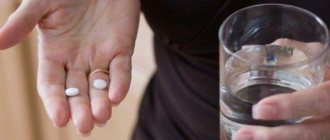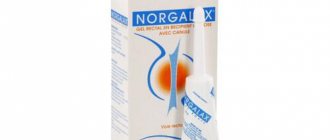Write a review
Reviews: 0
Active ingredients
- Osalmid
Disease class
- Gallstone disease [cholelithiasis]
- Cholecystitis
- Cholangitis
Clinical and pharmacological group
- Not indicated. See instructions
Pharmacological action
- Choleretic
- Antispasmodic
- Choleretic
- Cholekinetic
Pharmacological group
- Choleretic and bile preparations
Questions, answers, reviews about the drug Oxafenamide
You can look at questions about the drug, as well as ask your question to a specialist, using a free consultation with a pharmacist or pharmacist.
The information provided is intended for medical and pharmaceutical professionals. The most accurate information about the drug is contained in the instructions supplied with the packaging by the manufacturer. No information posted on this or any other page of our website can serve as a substitute for personal contact with a specialist.
| * | Our site does not sell medicines and other goods; they must be purchased in pharmacies, in accordance with current laws. Data on prices and availability in pharmacies is updated twice a day. Current prices can always be seen in the section Searching and ordering medications in pharmacies. |
Instructions
These instructions should be carefully studied, because... Failure to follow these recommendations may lead to negative consequences.
pharmachologic effect
The choleretic effect of the drug Oxafenamide is due to the content of osalmide. The medication belongs to the category of choleretics of synthetic origin. This remedy affects the entire digestive chain, normalizing the functioning of the liver and gall bladder. Taking Oxafenamide provides a significant improvement in the patient’s condition in the presence of diseases included in the list of indications for the drug.
Action of Oxafenamide:
- accelerating the process of bile production;
- effects on the liver at the cellular level;
- improving the performance of the digestive system;
- normalization of bilirubin levels in the body;
- reduction of muscle cell spasm;
- prevention of the development of atherosclerosis;
- accelerating the process of removing bile from the body;
- normalization of cholesterol levels in the blood;
- improving the blood supply to internal organs.
Indications
Attention! In order to purchase this product you do not need to show a prescription from a doctor.
Indications for the use of this drug are diseases such as:
The drug enhances the formation and secretion of bile, reduces spasms of the bile ducts.
- Cholecystitis, which occurs in a chronic form;
- Intrahepatic bile stagnation;
- Gallstone disease;
- Cholangitis;
- Preparation for duodenal intubation;
- Hepatitis, which is accompanied by cholecystitis.
Method of administration
Attention! Elderly patients may require dosage adjustment.
Oxafenamide tablets should be taken orally 15 minutes before meals. Food should be washed down with water (1/3 cup).
The doctor prescribes the drug in a dosage of 1-2 tablets 3 times a day. Therapy lasts 14-21 days, however, if necessary, treatment can be extended or repeated in case of exacerbation.
Children from 5 to 16 years of age are prescribed the medicine in a dosage of one tablet. The number of doses per day should be 2-3 times.
Compound
The medicine is available in the form of round tablets. The drug is placed in a cardboard box.
The drug Oxafenamide contains osalmide.
Drug interactions
The drug does not react with other drugs.
If there is an infection, Oxafenamide tablets must be combined with antibiotics.
Pharmacological properties
- The tablets promote a strong outflow of bile. The drug enhances the process of its formation and elimination, reducing the viscosity of the substance.
- Oxafenamide eliminates spasms of the proximal sphincter muscles. The medicine also stabilizes bilirubin levels and reduces cholesterol levels in the blood.
- The medicinal substance oslamide improves liver function, eliminating the leading signs of its dysfunction. These are nausea, yellowness of the skin and eyes, a bitter taste, pain in the rib, etc.
- Treatment with Oxafenamide leads to an improvement in liver function, normalization of bilirubin content in the blood serum, a decrease in the viscosity of bile and the content of leukocytes and mucus in it, and reduces cholesterol in the blood.
- There is an improvement in the general condition of patients, a decrease or disappearance of pain in the right hypochondrium, nausea, a feeling of bitterness in the mouth, a feeling of fullness in the epigastric region, itching, yellowness of the sclera and skin.
- The drug is low toxic.
Side effects
This remedy is tolerated quite well, but sometimes a backlash may occur, for example:
- Itching, swelling, urticaria;
- Cough, runny nose;
- Diarrhea, gas formation;
- Abdominal pain, flatulence, and bloating.
These conditions resolve on their own after reducing the dosage or stopping the drug Oxafenamide.
There have been no cases of overdose , however, doctors do not exclude the possibility of its occurrence. When taking the drug in a dosage that exceeds the permissible limit, appropriate treatment should be carried out.
Overdose
No episodes of Oxafenamide overdose have been recorded in medical practice, but experts do not rule out the occurrence of side symptoms if the dosage prescribed by the doctor or specified by the manufacturer is repeatedly exceeded.
A negative reaction of the body can manifest itself in the form of various pathological conditions. If they occur, it is recommended to stop the course of therapy and find out the cause of the adverse symptoms.
Overdose may be accompanied by the following conditions:
- bloating, flatulence and pain of various localizations;
- symptoms of urticaria (swelling and redness of the skin, rash accompanied by itching);
- diarrhea (accompanied by bloating, excessive gas and flatulence);
- allergy symptoms in the form of a runny nose, dry cough and swelling of the mucous membranes.
Contraindications
Attention! During the treatment period you should avoid drinking alcohol.
The drug should not be taken in conditions such as:
Before using the drug you should consult your doctor.
- Cirrhosis of the liver;
- Hepatitis, which is in acute form;
- Hypersensitivity to the main substance or auxiliary components of the drug;
- Obstructive jaundice;
- Any form of ulcer;
- Hepatosis.
The drug should be prescribed with increased caution for cholecystitis, as well as cholelithiasis, which are accompanied by angina pectoris. This is due to the fact that there is a risk of increasing cholecystocoronary syndrome.
During pregnancy
During pregnancy, doctors strongly do not recommend taking any medications. The drug Oxafenamide is no exception. However, there are cases when taking the drug is justified.
However, it is worth remembering that taking the drug must be accompanied by regularly taking all necessary tests, undergoing examinations and visiting a doctor.
Only if these recommendations are followed without reproach can we talk about effective treatment for the mother and safe for the baby.
You should also avoid taking this medication while breastfeeding . If it is still necessary to take the drug, then the method of natural feeding should be excluded for the duration of treatment.
Indications
Among the diseases for which treatment with this drug is indicated are the following:
- Cholangitis.
- Hepatitis in combination with cholecystitis.
- Stones in the gall bladder and ducts.
- Stagnation of bile.
- Biliary tract infections.
- Preparation for diagnostic measures.
Analogs
This medicine has a number of analogues that can replace the original medicine.
| A drug | Description |
| Cyqualon | The medicine contains cyclavolone. The drug has fewer side effects and the same contraindications. This medicine is also not available at the pharmacy. |
| Holosas | This medicine contains rosehip extract. The product has a large number of contraindications, but there are practically no side effects. The cost of the medicine was set at 85 rubles. |
| Gepabene | The composition of the medicine includes medicinal fume herbs. To purchase this medicine, you must show a prescription written by your doctor. The cost of the drug was set at 450 rubles. |
| Artichol | The medicine contains dry artichoke extract. The drug has an extensive list of contraindications and side effects. To purchase this drug there is no need to show a prescription from your doctor. The cost of medicine ranges from 200 to 267 rubles. |
| Holenzym | The drug has a large number of contraindications, but there are much fewer side effects. To purchase the drug, you must show a prescription from your doctor. The cost of medicine ranges from 140 to 167 rubles. |
| Tykveol | This medicine is available in capsule form. The drug can be used to treat a wide range of indications. To purchase this product you do not need to show a prescription from a doctor. The cost of the product ranges from 200 to 350 rubles. |
In addition, the drug can also be replaced with drugs such as Berberine, Flamin, Tykveol, Tanacechol, Holiver, Olimetin, Chofitol, Odeston.
special instructions
Impact on driving vehicles and operating machinery
No negative effects were identified.
Pregnancy and lactation
The drug is not used during pregnancy. The use of the drug during pregnancy and lactation is prescribed in isolated cases.
Use in childhood
The use of Oxafenamide is permitted only for children over five years of age.
For impaired renal function
The instructions do not contain data on the prohibition of taking the drug in case of impaired renal function.
In case of liver dysfunction
Liver failure is a contraindication for taking the drug.
Conditions for dispensing from pharmacies
The drug is sold without a prescription.
Contraindications
Oxafenamide is often well tolerated. But the drug has its own contraindications and side effects.
Thus, osalmide should be taken with caution for liver dystrophy, cholestatic hepatitis, obstructive jaundice, cirrhosis, and peptic ulcers. Relative contraindications are: cholecystitis and cholelithiasis, accompanied by cardiac arrhythmias.
Taking Oxafenamide in these cases often ends in the development of cholecystocoronary syndrome.
Reviews
There are practically no reviews about this product, but those that exist are mixed. Among the positive aspects, patients noted the low cost (up to 138 rubles) and the high effectiveness of the product.
Patients consider the lack of the drug in pharmacies to be a disadvantage of the drug. In addition, there are reports that the drug did not have the desired therapeutic effect. Some are dissatisfied with the release form, as well as the composition of the drug.
Did you know that the most common disease of the 21st century is liver disease? Find out more about liver disease: - How to recognize the first signs of hepatitis and effectively cope with the disease? — An interesting article about liver cirrhosis, you will learn about the history of the disease and its prevalence in the world. — Pain or discomfort in the right hypochondrium? Perhaps it's hepatosis! Find out how it can be cured.
Price
When setting the price, a number of nuances are taken into account, for example:
- Transportation costs;
- Purchase cost;
- Individual pharmacy markup;
- Place of sale.
Costs will vary significantly from country to country. These jumps can be clearly seen in the example of two neighboring countries, namely Ukraine and Russia. It is worth understanding that in addition to the above criteria, the formation of value is also influenced by the currency in the country and its exchange rate.
Video on the topic: How to get rid of bile stagnation using natural remedies
Russia
Currently, the drug is not available in pharmacies.
Ukraine
The product is not available in pharmacies.
Storage
The medicine should be stored indoors at a temperature of 15 to 27 degrees in a place where it will be quite cool. In addition, in no case should the drug be exposed to direct sunlight or droplets of water.
Attention! Under no circumstances should the drug be given to children or allowed for a pet to eat the medicine.
This medicine can be used for 5 years. An expired product is not allowed for further use, because such a medicine will not have the desired therapeutic effect. Sometimes such a drug can even be harmful.
Drug interactions
It is recommended to combine with antibacterial drugs for acute inflammatory processes in the biliary tract and gall bladder; for severe spasms and accompanying pain, it is advisable to simultaneously prescribe anticholinergics, papaverine and other antispasmodics


